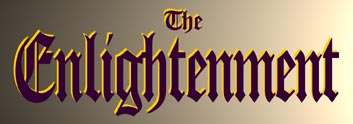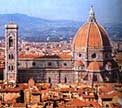Highlands Ranch High School - Mr. Sedivy
Highlands Ranch, Colorado

-
World History -
Scientific Revolution and The Enlightenment
Causes of the Scientific Revolution
During the Middle Ages people like Thomas Aquinas, while not stressing
observation, emphasized logic, clarification and articulation of
concepts, providing a basis for scientific thinking. The Renaissance
renewed interest in philosophy of the Greco-Roman days (Pythagorous).
The Renaissance also increased interest in mathematics. Art and
its desire to reproduce reality led to an increase in science knowledge.
Rise of National Monarchies
Monarchs provided money for scientific studies to centralize government,
promote trade, and reduce the influence of the church in state affairs.
In 1484 King John of Portugal appointed mathematicians to work out
a method for finding latitude at sea. In 1660 King Charles II established
the Royal Society and naval laboratories. Queen Elizabeth I established
Gresham College at Oxford to study navigation and astronomy c. 1597.

"The Queen's Universe." Political cartoon
of Queen Elizabeth I - 1588.
Reformation and Religious Conflicts
The printing press increased communication and the standardization
of knowledge. Religious conflicts led to an increase in toleration.
There was skepticism toward religion, thus, an atmosphere where
ideas could be more freely explored.

Johann Gutenberg inspects a printed sheet that has
just come off his new press.
Click the illustration for an
enlargement.
New Mathematics
 Arabic
numbers, introduced in the Renaissance, came increasingly into use
in the 16th century.
Arabic
numbers, introduced in the Renaissance, came increasingly into use
in the 16th century.
 Signs for addition, subtraction, multiplication, and division were
introduced by Francois Vieta in 1603. This became standardized so
all mathematicians used the same signs (printing press).
Signs for addition, subtraction, multiplication, and division were
introduced by Francois Vieta in 1603. This became standardized so
all mathematicians used the same signs (printing press).
 Logarithms were introduced by John Napier (Scotland). Logarithms
reduced to addition and subtraction the more complex and timely
math such as multiplication and long division.
Logarithms were introduced by John Napier (Scotland). Logarithms
reduced to addition and subtraction the more complex and timely
math such as multiplication and long division.
 Analytical Geometry was introduced by Renee Descartes in 1637. This
was useful in engineering and military ballistics.
Analytical Geometry was introduced by Renee Descartes in 1637. This
was useful in engineering and military ballistics.
 Calculus was introduced by Newton and Leibnitz in the 1660s. Calculus
measures quantifies variations in speed, which is useful for tabulating
the motions of planets.
Calculus was introduced by Newton and Leibnitz in the 1660s. Calculus
measures quantifies variations in speed, which is useful for tabulating
the motions of planets.

Galileo Galilei
Galileo Galilei (1564 - 1642)
Galileo was an Italian mathematics teacher, astronomer and physicist,
and one of the first true scientists. Galileo learned that a pendulum
took the same time to make a long swing as it did to make a short
one. He showed that light objects fell as fast as heavy ones when
pulled toward the earth (gravity).

Galileo demonstrates how his telescope works.
He built a telescope and became the first man to use
this tool to study the moon and planets. What he saw made Galileo
believe Copernicus's idea that the Earth was not the center of the
universe. The Church punished him for his belief in this idea. Later,
scientists like Isaac Newton built new knowledge on Galileo's discoveries.


Left: Copernicus. Right: Copernicus' heliocentric
model of the universe.
Isaac Newton (1642 - 1727)
Gravity. Even Newton thought that the idea that one body acts upon
another at a distance through a vacuum, without the mediation of
anything else, by and through which the action and force may be
conveyed from one to another, was to him so great an absurdity that
he believed no man could ever believe it. His equation of F=G X
mM/d2 basically says that the force of attraction between any two
bodies will be directly proportional to the product of their masses
and inversely proportional to the square of the distance between
them.
New Inventions
 Telescope (1608, Dutch) A Dutch glass maker construced a primitive
telescope. Galileo heard about it and improved on the design.
Telescope (1608, Dutch) A Dutch glass maker construced a primitive
telescope. Galileo heard about it and improved on the design.
 Microscope (1590s, Dutch)
Microscope (1590s, Dutch)
 Air pump (1650s, Dutch) - to study atmosphere
Air pump (1650s, Dutch) - to study atmosphere
 Pendulum clock (1657, Dutch) let scientists more accurately measure
time in their experiments
Pendulum clock (1657, Dutch) let scientists more accurately measure
time in their experiments
 Barometer (early 1600s, Italian) - measure air pressure
Barometer (early 1600s, Italian) - measure air pressure
 Thermometer (1611) for chemical and medical studies
Thermometer (1611) for chemical and medical studies
The Scientific Method
Modern scientists use the "scientific method." First, they observe
something carefully to find out everything they can about it. Then
they make a theory that explains what the thing is made of, or how
it works. Then they test the theory with experiments. If the experiments
agree with the theory, it becomes a "law" of science. Science is
always changing. Sometimes a scientific law is changed when scientists
discover new facts.
1.The Enlightenment and the Scientific Revolution
Causes, Inventions, Galileo, Newton, Scientific Method
2. The Enlightenment (Age
of Reason)
Man in the State of Nature - Locke, Voltaire




![]() 9375 South Cresthill Lane
9375 South Cresthill Lane ![]() Highlands Ranch, Colorado 80126
Highlands Ranch, Colorado 80126 ![]() 303-471-7000
303-471-7000





